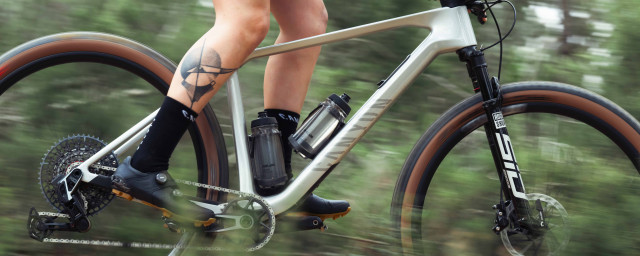The Topeak Smartgauge D2X is a lightweight, compact pressure gauge with a 360-degree swivel head compatible with Presta and Schrader valves. It's superbly accurate and easy to use while remaining small enough to throw in your bag or keep accessible in your home workshop.
- Everything you need to know about tubeless repair kits
- A buyer's guide to mountain bike handguards
- The complete 2021 RockShox suspension fork range
The latest edition of the Topeak Smartgauge digital pressure gauge sees improvements to the build and its features. The new D2X features 360-degree head movement, which is 180-degrees more than its predecessor, the D2 model. The build's revisions also see a 10g weight saving while expanding the pressure capacity to 260 psi (18bar).
Constructed from an engineering-grade polymer, the Smartgauge D2X is ideal for a wide range of uses, including road bikes, MTB / Fat bikes, motorcycle, and car tyres. The digital gauge provides accurate pressure readings up to 260psi / 18bar, read on the illuminated display. The device can display readings in psi, bar, kg / cm2, and the air-release button on the head allows you to fine-tune the pressure.
Additional features include a 360-degree swivel gauge, auto-on and auto-off functions and the last reading alarm. The Smartgauge D2X uses a CR2032 cell battery, which is included in the box. Topeak's claimed weight is 56g, with our test unit weighing 55g, with the battery, and 52g without.
How the Smartgauge D2X performed on test
I've used this gauge on both my mountain and gravel bike over the past few weeks. As someone who considers the weather, trail and terrain before setting off for a ride, occasionally, I'll make some pre-ride tweaks to my setup.
The Topeak Smartgauge D2X couldn't be more straightforward to use. With the sliding button on top to select the valve type: Presta or Schrader, turn on the device and choose your unit of measurement with the toggle button. Once you've removed the dust cap and loosened off the valve head, push the device to the valve, and the display will show the pressure of your tyre with a crisp beep sound.
What's great is that you don't need to faff with changing any heads or internals when switching between valve types. Assessing the pressure in your fork or shock and your tyres is straightforward at the flick of a button. Great for people like me, who are prone to losing small fiddly bits.
The back of the gauge head is shaped to cradle your thumb when applying to the valve, and the head rotates 360-degrees with an easy twist motion. This head rotation makes it convenient to reach awkward valves, while the illuminated display can still be easily read from varying angles thanks to its LCD backlit window.
To test the accuracy of the digital gauge, I inflated front and rear mountain bike tyres to 22psi using Topeak's new Tubi 2Stage track pump (review coming soon). When I applied the Smartgauge D2X, I was only 0.5psi out, which is acceptable considering the analogue dial on the track pump. I repeated this on my gravel bike and my partner's bike as well with little variation. I tend to slightly overinflate tyres with the track pump and then use the pressure-release button on the gauge to fine-tune the pressure to where I want it. The same process can be applied to shocks and forks also.
Value and verdict
If you're hot on your numbers and particular about your tyre and suspension setup, this neat gadget could be invaluable. At £40, the Topeak Smartgauge D2X is £15 cheaper than the Topeak Shuttle Digital gauge, which Jon rated a few years ago. Then there's the SKS Airchecker (2nd Gen), which retails for £28. However, the Airchecker's head only rotates 180-degrees and has a maximum pressure capacity of 144psi (10bar). Another popular digital pressure gauge is Schwalbe's AirMax Pro, which retails for around £13, but doesn't have a swivel head and is only suitable for Presta valves.
The Topeak Smartgauge D2X is a reliable, handy piece of kit, which isn't too overpriced. The ease-of-use is undoubtedly the key feature here as there's no faff involved when switching between valves types, the display is easy to read, and the 360-degree rotation of the head makes things much more manageable.














5 comments
you are correct. My comments were a bit hasty and wide of the mark all round really - but then I am not able to edit the post.
@sriracha. I presume the higher pressures are for suspension forks as mentioned in the headline.
The original D2 is a superb bit of kit, the light up display and the full rotation probably aids use. For the bike I have never needed full head rotation but when I have to do the better half a tyres on her car, the wheels are a little more difficult to rotate.
I've owned my D2 for about 6.5 years now and have been happy with it. I even dropped it in water once and it took me several minutes to fish out, yet it was fine afterwards despite not being advertised as waterproof.
I have pressure standards at work, I should test its accuracy some time.
Did you find any use for the measurement range above the 17bar limit of the D2, or even above the 10bar limit of the SKS? If not, why do you construe the higher 18bar limit as an advantage? If anything, in relegating most readings to a lower percentage of full scale it is likely to adversely impact accuracy, for no worthwhile gain.
What did you think about the smaller size of the readout compared to the D2? Has the D2X lost the bleed valve which is present on the D2?
How did you calibrate the reference pressure meter (on the track pump) before using it to discern the accuracy of the DX2?